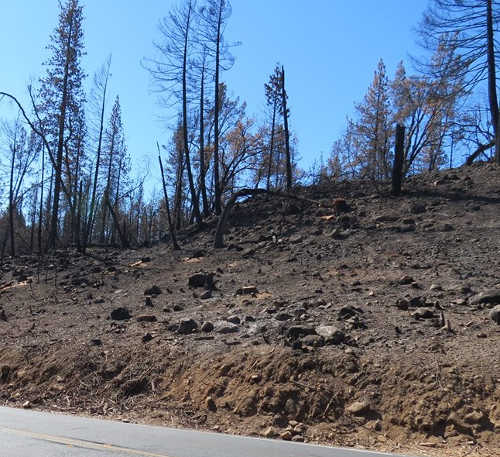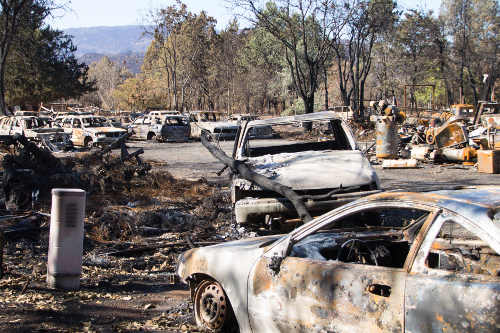- Elizabeth Larson
Lakeport City Council waives some housing rules to help Valley fire victims, gets update on cyanotoxin monitoring
LAKEPORT, Calif. – The Lakeport City Council last week took action to offer temporary changes in city rules in order to help Valley fire victims taking up residence in the city as the recovery process begins, and also heard a presentation regarding cyanotoxin monitoring on Clear Lake.
Community Development Director Kevin Ingram took the proposal to help fire survivors to the council at its meeting Oct. 6.
He presented the council with a proposal to waive the maximum 30-day stay allowance for transient housing – such as hotels and other accommodations – as well as lifting the initial service and deposit fees for new sewer and water connections for fire victims who are renting in the city.
Ingram said the city did an audit of local hotels to find out how many people would be impacted by the rule changes.
“The number is actually surprisingly pretty low,” he said, estimating there were about eight impacted families staying in such accommodations in the city.
He said the evacuation of the Clear Lake Riviera in the early days of the fire had the most impact on the city as far as accommodations.
When considering how they could provide relief for the fire's victims, Ingram said the 30-day stay and water and sewer startup fees were identified by staff as areas that likely would be most helpful.
The council unanimously approved the two actions.
In other council business, Sarah Ryan and Karola Kennedy, the environmental directors for Big Valley Rancheria and Elem Colony, respectively, presented an update on the Clear Lake Cyanotoxin Monitoring Program.
Ryan said tribal environmental protection programs have collected and provided the US Environmental Protection Agency with data on Clear Lake since the 1990s.
“The environmental protection programs are all about protecting natural resources,” including native species, in order to continue their use for food, ceremony and recreation, said Ryan.
The programs also seek to reduce the disproportionate impact of pollution on sensitive populations. That includes reducing negative impacts on the tribal communities as they pursue their spiritual and cultural rituals and practices, Ryan said.
She explained that cyanobacteria are naturally occurring bacteria organisms, also called blue green algae.
Cyanotoxins are produced by certain types of cyanobacteria, and some can be harmful to health. People and animals can be exposed to cyanobacteria through water contract, drinking water or – specifically to dogs – eating the mats.
She said 17 water purveyors are pulling water from the lake for drinking water.
In 2014 Elem and Big Valley began monitoring cyanotoxins, “because it was not happening in Lake County,” Ryan said.
They wanted to determine seasonal water quality trends and provide data on cyanotoxin-related toxins to support public health decisions.
“The tribes are concerned about the cyanotoxins and think we need to talk about this in a very transparent way,” Ryan said.
“When you start monitoring there are trends that you can see,” she continued, explaining that part of the program goal was to see if there were hot spots.
The Lakeport shoreline is doing very well this year, and has not exceeded thresholds set by the state. Last year it did, she said.
“It is a health issue,” she said, explaining that when healthy levels are exceeded, that information should be shared with the public.
Ryan said the US EPA requires all monitoring data be collected under a federally approved quality assurance plan that ensures standard operating procedures, a sampling design, standard methods and certified laboratories, and is both scientifically and legally sound.
In 2014 they monitored eight sites; this year, there are 18. Ryan said they're choosing high recreation areas, places where there are tules and septic systems, and tribally sensitive sites.
As for toxins commonly seen on Clear Lake, Ryan identified them as microcystins. They primarily affect the liver and can create issues for drinking water supply. There also are trace levels in the lake of anatoxins.
Nutrients like phosphorus and nitrogen at elevated levels impact the proliferation of cyanotoxins, she said.
Phosphorus comes from eroding soils, dirt roads, stormwater runoff, leaching septic tanks and fertilizers, while nitrogen can get into the lake through sewer spills, leaching septic tanks and stormwater runoff, according to the presentation.
The California EPA's Office of Environmental Health Hazard Assessment in 2012 created guidelines and thresholds for safe recreation, setting action levels for microcystins and other toxins, Ryan explained. For microcystins, the agency said 0.8 parts per billion for safe recreation. They don't, however, specify actions in response to higher results.
Before that, in 2010 the State Water Resources Control Board's Blue Green Algae Blooms Workgroup set its own safety thresholds, with anything over 8 parts per billion needed to result in the posting of health advisory warning signs, Ryan said.
“Let me just cut to the chase,” said Ryan, explaining that in 2014 the city of Lakeport had a recorded high level of 874 parts per billion at one of its sites. This year, no such detections were made.
Kennedy said the Clear Lake Cyanobacteria Task Force includes local tribes, the cities of Clearlake and Lakeport, Lake County Water Resources, Lake County Environmental Health, Lake County Public Health, US EPA Region 9 water and tribal programs, the State Water Resources Control Board, the California Office of Environmental Health Hazard Assessment, California Department of Public Health, Cal EPA and the Central Valley Regional Water Quality Control Board.
She said most of the eight monitoring sites in 2014 were tribally sensitive, with some also being recreational, such as Austin Park in Clearlake, and locations in Lucerne and the city of Lakeport.
The location with the highest level in 2014 was in Clearlake Oaks, about 50 yards off the offshore, near the water intake is. Kennedy said it was 17,000 parts per billion.
“The testing is one location at one point and one time,” she said, explaining that last year they advocated for signage along the shoreline where readings were beyond the threshold.
In 2014, the city of Lakeport's highest result was at the First Street boat ramp, where the reading was 877 parts per billion. Kennedy said through the seven sampling events they had, there was only two times during that sampling that Lakeport was over the limit.
This year, they're taking samples at 18 sites, with EPA recommending more recreational sampling, she said. They also now look at cyanotoxins to do cell identification to determine what type of cyanotoxins they're finding.
Kennedy said the Scotts Valley tribe has received a grant to pay for warnings signage to be posted around the lake. The signage can be changed to range from low, medium to high.
She said there has been some testing of drinking water among the 17 water purveyors on the lake.
In 2013 there were no cyanotoxin detects in the finished – or treated – drinking water from those water purveyors, although some raw water had some microcystin levels. As an example, she said Highlands Water, which pulls water from near Redbud Park in Clearlake, had the highest result of 23.8 parts per billion in the raw water.
Since the fires, the lake has become inhabited by diatoms – a group of algae and a type of phytoplankton – and the cyanobacteria has gone away, with that becoming another source of study for the program, Kennedy said.
Kennedy said there are regulations for microcystins in water, just guidelines and recommendations.
In the 1990s the World Health Organization offered guidelines for 1 part per billion, with the US EPA earlier this year proposing 0.3 parts per billion for children under age 6 and 1.6 parts per billion for adults for microcystin, and for cylindrospermopsin – another kind of cyanotoxin – the levels were set at 0.7 parts per billion for children under age 8 and 3 parts per billion for adults, Kennedy said.
Ryan said Clearlake has hot spots this year along its shoreline.
She said Big Valley has been removing weeds manually – not with chemicals – as part of a nutrient removal program. It's also an activity that can access grant funding.
Ryan said they have removed 75 tons of weeds from the lake. They're composting the weeds and have found through lab study that the weeds are high in nitrogen and phosphorus, and make great fertilizer. She said it could be the basis for a business.
The tribe also uses aeration to break up the blue green algae mats, Ryan said. Cyanobacteria would rather be in areas where there is lower oxygen.
As a result of these efforts, the measurements on the Big Valley shoreline have been very low, around 1 part per billion, she said.
Ryan and Kennedy offered the council several suggestions at the end of their presentation.
“We do believe that signage is extremely important to inform the public of risks and options,” Ryan said.
They suggested signage that is more specific than current signage, which says to avoid blooms. Even after blooms die, the toxins can still be present in the water for up to two weeks. People avoiding blooms aren't necessarily avoiding toxins, Ryan said.
Other suggestions included press releases, development of a nonchemical weed abatement program, aerating shorelines and considering water purveyors to test for cyanotoxins in treated drinking water when shoreline levels are elevated.
Councilman Kenny Parlet said he was concerned about the impact of the signs.
“I've been here for 46 years, and if I wanted to close down Lake County, that's exactly what I would do is put those signs up,” he said.
Ryan said the signs would only be present when levels were unsafe. Parlet replied that the last thing he wanted was to see signs up warning of cyanotoxins when it's not necessary and there isn't a problem.
She said Kennedy had done a test at a well-used beach where the level was found to be 10,000 parts per billion, but the results hadn't come in for a week. They're working with doctors and vets to put together a credible list of illnesses resulting from exposures.
Parlet said he wanted to see photographic correlations with areas where test results are high.
Kennedy said notification is important to let people know where they can safely recreate. She added they do photograph sites where testing occurs.
Councilwoman Stacey Mattina asked if there were grants for prevention. Ryan said there was but the deadline had passed. She said the cities and tribes should get together and apply jointly for grants.
Parlet asked about the benefit of the Middle Creek Restoration Project area on the Northshore. Ryan said she's given up as it, because she doesn't believe people will sell their land. Instead, they're looking at doing erosion prevention, tule replanting and other types of project on creeks.
In other business at the Tuesday meeting, the council presented a proclamation designating October 2015 as Domestic Violence Awareness Month to Lake Family Resource Center representatives; Rebecca Southwick updated the council on that week's Lake Leadership Summit; and Lake County Chamber Chief Executive Officer Melissa Fulton presented the city with a check for more than $3,300 to go toward the city's annual July 4 fireworks display.
The council also held public hearings and approved amendments and revisions to existing ordinances relating to establishing a review process for small residential rooftop solar energy systems, imposing additional licensing fees on fortunetellers and allowing for the issuance of special parking permits for residential units in the central business district that don't have access to on-site parking.
The council held another public hearing and adopted the ordinance forming the Lakeport Industrial Development Authority, which was necessary to meet the US Department of Agriculture's funding requirements for the new Lakeport Police headquarters; confirmed current council signatories for city warrants and checks and adopted the a resolution adding the Lakeport Police chief as a signatory.
Email Elizabeth Larson at






 How to resolve AdBlock issue?
How to resolve AdBlock issue? 



